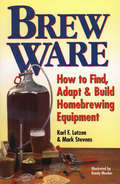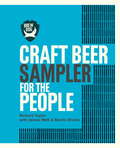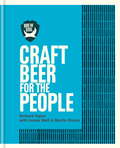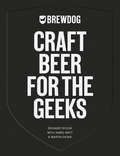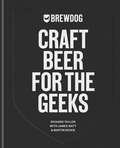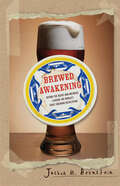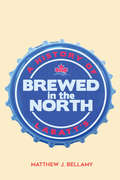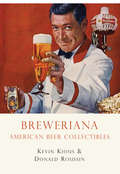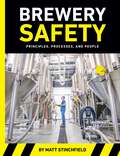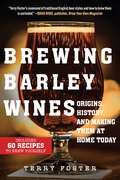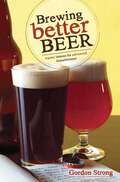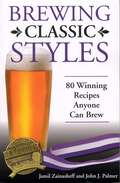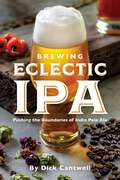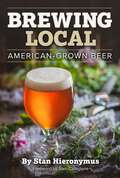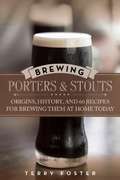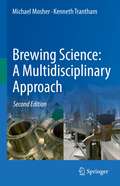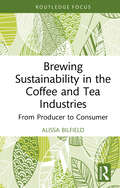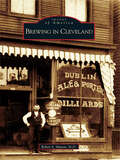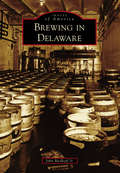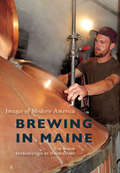- Table View
- List View
Brew Ware: How to Find, Adapt & Build Homebrewing Equipment
by Mark Stevens Karl F. LutzenGear up with the right equipment and take the hassle out of homebrewing. <P><P>Karl E. Lutzen and Mark Stevens guide you through the best tools for all your brewing needs, from DIY homemade versions of commercial brewery equipment to simple devices that make brewing easier and safer. <P><P>Learn which gadgets and gizmos work best for measuring, mashing, bottling, kegging, and more. With the proper tools close at hand you’ll save both time and money, leaving you free to focus on enjoying your homebrewed beers.
BrewDog: Craft Beer For The People
by Richard Taylor James Watt Martin DickieBrewDog is one of the world's fastest-growing food and drink brands. Their first beer book focuses on explaining craft beer to the widest possible audience. It includes a survey of what makes craft beer great, how to understand different beer styles, how to cook with beer and match beers and food, right through to how to brew your own. We hope that you enjoy this free sampler.
BrewDog: Craft Beer For The People
by Richard Taylor James Watt Martin DickieIncludes pull-out beer matsBrewDog's first beer book is a brilliant intro to the world of craft beer. It includes a look at what makes craft beer great and how it's made, explains how to understand different beer styles, how to cook with beer and match beers and food, right through to how to brew your own at home. It's not just about BrewDog's beers either - plenty of other excellent breweries and their beers from around the world are featured. This book is both a window into the BrewDog world and a repository of essential craft beer information.Designed in the highly individual style of the brand, the book also includes quirky features such as spaces to place your drop of beer once you've ticked a particular beer off your 'to-drink' list and pull-out beer mats.
BrewDog: Craft Beer for the Geeks
by Richard Taylor; James Watt; Martin DickieThe second book from the founders of Brewdog: Craft Beer for the Geeks aims to go deeper into the science and styles of craft beer in this full-color, gorgeously designed taproom bible. With sections such as "The Science of Flavor" and "Why Temperature Is King," beer geeks will be satisfied with the wealth of knowledge presented by these craft beer experts. Recipes and sections on beer and food pairing will thrill food and beverage enthusiasts who want to go further in exploring flavor combinations. And a "DIY Dog" section on at-home brewing with recipes and trouble-shooting tips exemplifies the punk, open-source ethos that Brewdog is known for.
BrewDog: Craft Beer for the People
by James Watt Martin Dickie Dr Richard TaylorBrewDog's first beer book is a brilliant intro to the world of craft beer. It includes a look at what makes craft beer great and how it's made, explains how to understand different beer styles, how to cook with beer and match beers and food, right through to how to brew your own at home. It's not just about BrewDog's beers either - plenty of other excellent breweries and their beers from around the world are featured. This book is both a window into the BrewDog world and a repository of essential craft beer information.Designed in the highly individual style of the brand, the book also includes quirky features such as spaces to place your drop of beer once you've ticked a particular beer off your 'to-drink' list and pull-out beer mats.
BrewDog: The masterclass, from exploring iconic beers to perfecting DIY brews
by BrewDog PLC****Black Hardcover Edition* The new book from BrewDogRelease your inner beer geek. BrewDog wrote the ultimate book for beer virgins. Now they have gone deeper. Deep niche deeper. Here you will find everything BrewDog loves about beer and brewing distilled into one must-read volume. You will explore the evolution of styles such as IPA and wheat beer into the myriad innovative forms they take today; discover which beers BrewDog believes are truly iconic and why; learn to perfect your own DIY brews, with recipes from many breweries to choose from; find menus for whole beer- and foodpairing dinners; and of course enjoy the beers from all around the world that should be tasted right now. In a nutshell this is a masterclass in craft beer.
Brewed Awakening: Behind the Beers and Brewers Leading the World's Craft Brewing Revolution
by Joshua M. BernsteinFine wine has always had its expert guides to taste and terroir. Why not beer? Funky, young, and smart, this is the ultimate beer geeks companion, covering everything from the homebrew renaissance to nanobreweries to many of Americas preeminent beer events and festivals. Theres a revolution brewing among craft beer makers: Theyre reviving long-forgotten recipes, dosing brews with wild yeasts to create new flavors, and using organic grains and hops to forge a delicious new frontier of beer. And no ones better equipped to tell us whats happening than Joshua M. Bernstein, former Gourmet.com writer and one of the worlds foremost beer experts. He covers all of todays top trends, including high-alcohol, bourbon barrel-aged, cask-conditioned, and even gluten-free beers. Designed to look just like Joshuas notebook and featuring labels and photos, this extreme guide is a one-stop shop for cutting-edge beer technology, taste, and information.
Brewed in Canada: The Untold Story of Canada's 350-Year-Old Brewing Industry
by Allen Winn SneathWinner of the 2002 North American Guild of Beer Writers’ Quill & Tankard Annual Writing Award The Canadian brewing industry predates Confederation by two hundred years; Canada boasts the oldest, continuously operating brewery in North America. Canadian brewers have survived the persecution of the Temperance Movement and Prohibition, the Great Depression, two World Wars and the challenge of Free Trade. Today, brewing in Canada is a 10 billion dollar business whose one constant is change. From its colonial past to the microbrewery renaissance, Brewed in Canada is a passionate narrative of individual power, colourful characters, family rivalries and foreign ownership. Individual stories tell of personal success and failure, bankruptcies, takeovers, consolidation and rationalization. As men of influence, these brewers made significant contributions to their local communities and the country. Beyond the day-to-day operation of their brewing business, some would make their mark in politics, while others built churches, hospitals and helped establish universities. A commitment to community service - and to brewing excellence - continues today.
Brewed in Michigan: The New Golden Age of Brewing in the Great Beer State
by William RapaiBrewed in Michigan: The New Golden Age of Brewing in the Great Beer State is William Rapai’s “Ode on a Grecian Urn”—a discussion of art and art’s audience. The art in this case is beer. Craft beer. Michigan craft beer, to be exact. Like the Great Lakes and the automobile, beer has become a part of Michigan’s identity. In 2016, Michigan ranked fifth in the number of craft breweries in the nation and tenth in the nation in craft beer production. Craft brewing now contributes more than $1.8 billion annually to the state’s economy and is proving to be an economic catalyst, helping to revive declining cities and invigorate neighborhoods. This book is not a beer-tasting guide. Instead, Rapai aims to highlight the unique forces behind and exceptional attributes of the leading craft breweries in Michigan. Through a series of interviews with brewmasters over an eighteenth-month sojourn to microbreweries around the state, the author argues that Michigan craft beer is brewed by individuals with a passion for excellence who refuse to be process drones. It is brewed by people who have created a culture that values quality over quantity and measures tradition and innovation in equal parts. Similarly, the taprooms associated with these craft breweries have become a conduit for conversation—places for people to gather and discuss current events, raise money for charities, and search for ways to improve their communities. They’re places where strangers become friends, friends fall in love, and lovers get married. These brewpubs and taprooms are an example in resourcefulness—renovating old churches and abandoned auto dealerships in Michigan’s biggest cities, tiny suburbs, working-class neighborhoods, and farm towns. Beer, as it turns out, can be the lifeblood of a community. Brewed in Michigan is a book for beer enthusiasts and for people who want a better understanding of what makes Michigan beer special. Cheers!
Brewed in the North: A History of Labatt's
by Matthew J. BellamyFor decades, the name Labatt was synonymous with beer in Canada, but no longer. Brewed in the North traces the birth, growth, and demise of one of the nation's oldest and most successful breweries. Opening a window into Canada's complicated relationship with beer, Matthew Bellamy examines the strategic decisions taken by a long line of Labatt family members and professional managers from the 1840s, when John Kinder Labatt entered the business of brewing in the Upper Canadian town of London, to the globalization of the industry in the 1990s. Spotlighting the challenges involved as Labatt executives adjusted to external shocks - the advent of the railway, Prohibition, war, the Great Depression, new forms of competition, and free trade - Bellamy offers a case study of success and failure in business. Through Labatt's lively history from 1847 to 1995, this book explores the wider spirit of Canadian capitalism, the interplay between the state's moral economy and enterprise, and the difficulties of creating popular beer brands in a country that is regionally, linguistically, and culturally diverse. A comprehensive look at one of the industry's most iconic firms, Brewed in the North sheds light on what it takes to succeed in the business of Canadian brewing.
Breweriana
by Kevin KiousThough beer is one of the oldest beverages around, beer can collecting--particularly in the United States--really picked up steam in the 1930s when beer in cans first appeared. Since then, beer can collecting and breweriana has become vastly popular, with a variety of clubs and associations springing up across the country and around the world. Brewery collectibles became especially popular in the 1970s, and today breweriana remains a popular pastime, especially with the onset of the microbrew revolution. Author Kevin Kious explores the history of beer and collecting in Breweriana. Kious looks at the evolution of beer cans, paper advertising, packaging, and signage, as well as how Prohibition affected the industry in the 1920s and early 1930s and how consolidation changed things in the 1970s. Breweriana will be of interest not only to beer lovers but also to readers with an interest in advertising, packaging, and signage.
Brewery Safety: Principles, Processes, and People
by Matt StinchfieldBrewers of all sizes should uphold the value of safety alongside their edgy brands and creative and carefully crafted beers and other beverages. It's the responsibility of all brewery employees to assess hazards, learn how to control or eliminate them, and to document and train each other on the safest ways to perform tasks. It's not just about government regulation, but it is also about making your brewery the best brewery possible—for your beer, your staff, and your visitors. Breweries face hazards that can be divided into physical, chemical, biological, ergonomic, and psychosocial hazards. Learning to address these aspects of safety to ensure a safe product and working environment is paramount. From physical trauma to chemical irritations, biological hazards to psychosocial hazards, Brewery Safety explores in-depth how to think about and avoid these hazards. Brewers will learn to evaluate, educate, and execute safety conscious measures to ensure that the working environment, welfare of staff, and the quality of the product are first and foremost.
Brewing Barley Wines: Origins, History, and Making Them at Home Today
by Terry FosterFor Craft Beer Drinkers and Homebrewers Alike From early English origins to modern American examples like Sierra Nevada&’s Bigfoot and Rogue&’s XS Old Crustacean, barley wines are a favored style among homebrewers and craft beer drinkers alike. In Brewing Barley Wines, widely respected beer and brewing writer Terry Foster presents the history and development of the style as well as the guidance and expertise necessary to successfully homebrew it yourself. The book opens with an exploration of the definition of the style from its murky past to somewhat arbitrary modern standards. Foster explores the style guidelines given by the Brewers Association (BA) and the Beer Judge Certification Program (BJCP) and finds them to be narrow, even faulty, showing that many beers not designated as barley wines—including some stock ales, Scotch ales, wheat wines, and even double IPAs—can be said to fit the style. Foster then goes on to give a history of barley wine, which saw its first specifically labeled commercial example as recently as 1903, but which has been produced for centuries under a variety of names. Originally an English style, barley wines were not generally brewed in America until the rise of craft brewing in the late twentieth century. But having cemented a foothold in the New World, with many craft breweries having at least one featured example and sometimes several, barley wines are now rarely produced by British brewers due to heavy taxation on strong beers. Foster then examines the ingredients used in barley wines as well as best practices and procedures for brewing them, including how to create and successfully manage the high-gravity worts required for making these beers. Finally, Foster provides a collection of sixty recipes showcasing the variety and range of ingredients explored in the book with detailed instructions for making them at home.Brewing Barley Wines belongs in the library of every craft beer drinker or homebrewer.
Brewing Better Beer: Master Lesson for Advanced Homebrewers
by Gordon StrongOne of the most successful and respected homebrewers in America and highest ranking judges in the BJCP, there are few candidates better placed than Gordon Strong to give advice on how to take your homebrew to the next level. In Brewing Better Beer, the author sets out his own philosophy and strategy for brewing, examining the tools and techniques available in an even-handed manner. The result is a well-balanced mix of technical, practical, and creative advice aimed at experienced homebrewers who want to advance to the next level.The book is also a story of personal development and repeatedly mastering new systems and processes. Strong emphasizes that brewing is a creative endeavor underpinned by a firm grasp on technical essentials, but stresses that there are many ways to brew good beer. After mastering techniques, equipment, ingredients, recipe formulation, and the ability to evaluate their own beers, the advanced homebrewer will know how to think smart and work less, adjust only what is necessary, and brew with economy of effort. The author also pays special attention to brewing for competitions and other special occasions, distilling his own experiences of failure and (frequent) triumphs into a concise, pragmatic, and relaxed account of how judging works and how to increase your chances of success.The author's insights are laid out in a clear, engaging manner, deftly weaving discussions of technical matters with his own guiding principles to brewing. Learn to identify process control points in mashing, lautering, sparging, boiling, chilling, fermenting, conditioning, clarifying, and packaging. What are the best ways to control mash pH, which mash regimen suits your process, how can you effectively control your process through judicious equipment selection? Other tips on optimizing your brewing include ingredient and yeast selection, envisioning a recipe and bringing it to fruition, planning your brewing calendar, and identifying the critical path to ensure a successful brew day.There is also a detailed discussion of troubleshooting to address technical and stylistic problems advanced homebrewers often face. Through it all, Strong highlights you are the ultimate arbiter, giving advice on how to judge your own beers and understanding how balance takes many forms depending on style.
Brewing Classic Styles: 80 Winning Recipes Anyone Can Brew
by John Palmer Jamil ZainasheffAward-winning brewer Jamil Zainasheff teams up with homebrewing expert John J. Palmer to share award-winning recipes for each of the 80-plus competition styles. Using extract-based recipes for most categories, the duo gives sure-footed guidance to brewers interested in reproducing classic beer styles for their own enjoyment or to enter into competitions.
Brewing Eclectic IPA: Pushing the Boundaries of India Pale Ale
by Dick CantwellAs a diverse but distinctive style, IPA bestrides the craft beer world like a colossus. As author Dick Cantwell says, &“We are living in the heyday of IPA.&” While hops remain front and center in the myriad examples of IPA available to beer drinkers today, the style is also now subject to vast experimentation and &“dressing-up,&” producing fruity, herbal, black, Belgian-y, and juicy versions of this perennial favorite. Brewers are pushing the boundaries of IPA by using flavors from cocoa, coffee, tea, fruits, vegetables, spices, herbs, chilis, and wood.Before describing how this multitude of ingredients can best be applied to crafting unique, eclectic, and tasty IPAs, Cantwell gives a potted history of IPA, acknowledging some of the fanciful notions the story often includes. When he arrives at craft brewing today, Cantwell opens up whole new vistas where experimentation can happen, involving spices and herbs of all kinds, fruits from every corner of the globe, vegetables familiar and not-so-familiar, coffee and chocolate, teas and botanicals. Along the way, he describes his thoughts behind his approach and how to treat these ingredients with free license while still being conscious that the aim is to produce something delicious that people will want to drink again.Brewing Eclectic IPA will inspire professional and homebrewers alike to explore the creative ways in which these ingredients can be used in brewing highly hopped beers. Try your own version using any of the 25 recipes for contemporary IPAs that the book contains, designed by some of America's top brewers.
Brewing Everything: How To Make Your Own Beer, Cider, Mead, Sake, Kombucha, And Other Fermented Beverages (Countryman Know How #0)
by Dan CrissmanEasy and authentic ways to ferment delicious beverages at home Brewing Everything is a thorough, accessible, and humorous guide to brewing anything from beer to cider to sake. For every brewing project there is both an easy way and a hard way, a method useful to both the curious novice and the hardcore brewing veteran. Each chapter includes interviews with experts (brewmasters, cidermakers, new meadery startups, and small-batch kombucha sellers) as well as the author’s own home- tested recipes. Brewing Everything walks you through the process from start to finish, beginning with easier shortcuts until you get the hang of it, and then upgrading to the harder stuff after you’ve brewed a thing or two. With step-by-step instructions, color photographs, and methods for every level of experience, this is the ultimate guide to all things home brew.
Brewing Local: American-Grown Beer
by Stan HieronymusBeer has never been a stranger to North America. Author Stan Hieronymous explains how before European colonization, Native Americans were making beer from fermented corn, such as the tiswin of the Apache and Pueblo tribes. European colonists new to the continent were keen to use whatever local flavorings were at hand like senna, celandine, chicory, pawpaw, and persimmon. Before barley took hold in the 1700s, early fermentables included corn (maize), wheat bran, and, of course, molasses. Later immigrants to the young United States brought with them German and Czech yeasts and brewing techniques, setting the stage for the ubiquitous Pilsner lagers that came to dominate by the late 1800s. But local circumstances led to novel techniques, like corn and rice adjuncts, or the selection of lager yeasts that could ferment at ale-like temperatures. Despite the emergence of brewing giants with national distribution, &“common brewers&” continued to make &“common beer&” for local taverns and pubs. Distinctive American styles arose. Pennsylvania Swankey, Kentucky Common, Choc beer, Albany Ale, and steam beer—now called California common—all distinctive styles born of their place. From its post-war fallow period, the US brewing industry was reignited in the 1980s by the craft beer scene. Follow Stan Hieronymous as he explores the wealth of ingredients available to the locavores and beer aficionados of today. He takes the reader through grains, hops, trees, plants, roots, mushrooms, and chilis—all ingredients that can be locally grown, cultivated, or foraged. The author supplies tips on how to find these as well as dos and don'ts of foraging. He investigates the nascent wild hops movement and initiatives like the Local Yeast Project. Farm breweries are flourishing, with more breweries operating on farms than the US had total breweries fewer than 50 years ago. He gives recipes too, each one showing how novel, local ingredients can be used to add fermentables, flavor, and hop-like bitterness, and how they might be cultivated or gathered in the wild. Armed with this book, brewers in America have never been better equipped to create a beer that captures the essence of its place.
Brewing Made Easy, 2nd Edition: A Step-by-Step Guide to Making Beer at Home
by Joe Fisher Dennis FisherGet brewing! This foolproof beginner’s guide to brewing great beer at home includes everything you need to know to make your very first batch. With step-by-step instructions, insightful advice, and simple recipes for a variety of beer styles, you’ll be proudly sipping your own homemade beer in no time. This revised edition covers additional techniques and equipment, as well as new varieties of hops and other ingredients. Ground yourself in the basics of homebrewing and experiment with new tastes and combinations. It’s fun, easy, and oh-so-rewarding!
Brewing Porters and Stouts: Origins, History, and 60 Recipes for Brewing Them at Home Today
by Terry FosterFrom the enduring global dominance of Guinness to exciting new craft porters to the resurgence of Russian imperial stouts, porters and stouts are among the most popular beer styles today among homebrewers and craft beer drinkers alike. In Brewing Porters and Stouts widely respected beer and brewing writer Terry Foster presents the history and development of these styles as well as the guidance and expertise necessary to successfully homebrew them yourself.The book opens with the history of the styles, including the invention of porter in eighteenth-century England, how stouts were born from porters (stouts were originally bolder and stronger or stout porters), the development in the United Kingdom, and introduction to Ireland and eventually the United States, where they remained popular even as they fell out of favor in Britain and surged in popularity as the craft brewing revolution took hold. Foster then goes on to explore the many sub-styles of porters and stouts, providing commercial examples and showcasing some of the most exciting developments in craft brewing today, before breaking down the ingredients, including the various malts as well as special flavorings-such as vanilla, coffee, chocolate, and even bourbon-and finally the yeasts, hops, and waters that are well suited to brewing these styles. Finally, Foster provides a collection of sixty recipes-up to six for each sub-style-showcasing the variety and range of ingredients explored in the book and providing both extract and all-grain instructions.Brewing Porters and Stouts belongs in the library of every craft beer drinker or homebrewer.
Brewing Science: A Multidisciplinary Approach
by Michael Mosher Kenneth TranthamThis updated text collects all the introductory aspects of beer brewing science into one place for undergraduate brewing science courses. This expansive and detailed work is written in conversational style, walking students through all the brewing basics from the origin and history of beer to the brewing process to post-brew packaging and quality control and assurance. As an introductory text, this book assumes the reader has no prior knowledge of brewing science and only limited experience with chemistry, biology and physics. The text provides students with all the necessary details of brewing science using a multidisciplinary approach, with a thorough and well-defined program of in-chapter and end-of-chapter problems. As students solve these problems, they will learn how scientists think about beer and brewing and develop a critical thinking approach to addressing concerns in brewing science. As a truly comprehensive introduction to brewing science, Brewing Science: A Multidisciplinary Approach, Second Edition walks students through the entire spectrum of the brewing process. The different styles of beer, the molecular makeup and physical parameters, and how those are modified to provide different flavors are listed. All aspects of the brewery process, from the different setup styles to sterility to the presentation of the final product, are outlined in full. All the important brewing steps and techniques are covered in meticulous detail, including malting, mashing, boiling, fermenting and conditioning. Bringing the brewing process full circle, this text covers packaging aspects for the final product as well, focusing on everything from packaging technology to quality control. Students are also pointed to the future, with coverage of emerging flavor profiles, styles and brewing methods. Each chapter in this textbook includes a sample of related laboratory exercises designed to develop a student’s capability to critically think about brewing science. These exercises assume that the student has limited or no previous experience in the laboratory. The tasks outlined explore key topics in each chapter based on typical analyses that may be performed in the brewery. Such exposure to the laboratory portion of a course of study will significantly aid those students interested in a career in brewing science.
Brewing Sustainability in the Coffee and Tea Industries: From Producer to Consumer (Earthscan Food and Agriculture)
by Alissa BilfieldThis book focuses on the often intertwined industries of coffee and tea, using accounts of single producer communities to highlight the transformation from plantation-style colonial agriculture towards systems that now claim to produce social and environmental benefits from the farm to the cup. Focusing on the dynamics of farmers' experiences producing coffee and tea ethically and sustainably at origin, the book shows how these values are transmitted and reinforced throughout the value chain. Exploring tandem case studies of fair trade cooperatives in Guatemala and Sri Lanka, it provides an insight into the creation of more sustainable value chains from producer to consumer in the global marketplace, incorporating the perspectives of coffee exporters, importers, roasters, and café owners. This book is focused on the prospects of the specialty movement in food as a catalyst for forging more authentic, just, and sustainable supply chains that consider both people and the environment. This book will be of great interest to students and scholars of food and agriculture, sustainable food systems and supply chains, the fair trade movement, sustainable development, and social entrepreneurship and social innovation.
Brewing in Cleveland (Images of America)
by Robert A. MussonBeginning in the mid-1800s, the beer-brewing industry in Cleveland experienced its most extensive growth due to the rapidly increasing immigrant population of mostly Germans,Czechs, and Irish. The breweries enjoyed great success until the Prohibition era closed all brewing operations down for 14 dry years. In 1933, the industry started anew, andClevelanders were able to enjoy locally made beer for 50 more years before business conditions led to the industry's second demise. Today the industry has once again experienced a rebirth, this time on a smaller scale with theemergence of a number of popular brewpubs and microbreweries.
Brewing in Delaware (Images of America)
by John Medkeff Jr.While Delaware maintains one of the oldest beer-brewing traditions in the United States, its history has largely been lost or forgotten over the course of nearly four centuries. Beer was a main source of sustenance to Delaware's early European settlers, and its production eventually became one of the young colony's first industries. From its humble colonial beginnings, beer production grew to become one of the state's largest and most profitable industries. National Prohibition put a temporary end to the golden age of brewing in Delaware; however, the industry made a modest recovery after repeal. The state's two remaining breweries ultimately fell victim to larger, better funded regional and national concerns. There would be no brewing in Delaware for the next four decades. The remarkable popularity of craft beer in the 1990s fueled a brewing revival in the state, punctuated by Delaware's nationally recognized, award-winning breweries.
Brewing in Maine (Images of Modern America)
by David Geary Tom MajorMaine was once a national leader in the temperance movement to outlaw alcohol. In the last 30 years, however, the Pine Tree State has been equally influential in the craft beer movement. Since 1986, when David and Karen Geary opened New England's first microbrewery, more than 50 breweries have opened in Maine. The state not only ranks among the top 10 for breweries per capita, it also boasts two of the 50 largest craft breweries in the country. The personalities and visions of the brewers are as diverse as the beers they create. Some have opened their breweries in the hulking mill complexes of Lewiston and Biddeford or the former factories of Portland. Others have brewed at the scenic mountain resorts of Sugarloaf and Sunday River or on the quaint, historic wharves of Belfast and Kennebunk, and even on distant Monhegan Island. Farmstead breweries have sprung up from Skowhegan to Lyman, while the state's industrial parks are no less fertile.
